Sleep is an important part of our daily life that we often times take for granted. Studies have discovered that sleep helps in tissue growth, mental consolidation and recovery. Research also shows that a chronic lack of sleep, or getting poor quality sleep can increase the risk of disorders like high blood pressure, cardiovascular disease, diabetes, depression, and obesity.
![]()
The Galaxy Watch 4 can automatically track your sleep when you wear it to sleep. It tracks your sleep in four stages as well as gives you a score based on 5 factors which we discussed at the end of this article. The Galaxy Watch 4 can also track calories burnt, your blood oxygen during sleep and can detect snoring. In this guide, you will learn about the various stages of sleep and their benefits, you will also learn how to track sleep with the Galaxy Watch 4 as well as how you can track snoring and your blood oxygen during sleep.
Types of sleep stages and Their Benefits
According to sleep researchers, there are 5 stages of Sleep; The Wake stage, N1, N2, N3, and the rapid eye movement (REM) stage. Sleep is further divided into two; NREM and REM. NREM comprises N1, N2, and N3.
The N1 and N2 are referred to as light sleep while the N3 stage is referred to as deep sleep.
- Wake stage
- N1 stage (5% of total sleep)
- N2 Stage (45% of total sleep)
- N3 Stage (25% of total sleep)
- REM stage (25% of total sleep)
The first stage is the wake stage. This is when we’re still awake and just winding down to sleep. According to EEG recordings of the brain, this stage is characterized by Beta and alpha waves. Beta waves dominate when our eyes are still open while alpha waves dominate when we close our eyes.
The second stage of sleep is the N1 stage which is the lightest form of sleep and accounts for 5% of total sleep. In this stage, breathing is regular and muscle tone occurs in the skeletal muscles. The EEG recordings of the brain shows the N1 stage is characterized by low voltage theta waves, and it begins when more than half of the alpha waves are replaced by low amplitude mixed-frequency activity.
The third stage is the N2 stage which is a deeper form of light sleep, and it accounts for 45% of total sleep. The EEG recordings of this stage show its characterized by sleep spindles, k-complexes, or both.
Sleep spindles are powerful neuronal firings that according to studies help in memory consolidation. On the other hand, K-complexes are long delta waves that according to studies play an important role in maintaining sleep and memory consolidation.
The fourth stage is the N3 stage which is the deepest form of sleep and it accounts for 25% of total sleep. The EEG recordings of this stage show its characterized by low-frequency delta waves where the muscle is totally relaxed, breathing is regular and heart rate is slowed. It’s in this stage that the body undergoes repairs, builds muscle and bones as well as strengthens the immune system. It’s very hard to wake anyone in the deep sleep stage, and it’s in this stage that bedwetting and sleepwalking occur. Deep sleep is predominant in the 2nd phase of sleep cycle and decreases in subsequent phases.
The last stage of sleep is the REM stage. EEG recordings show that this stage is characterized by beta waves similar to when we are awake. However, during this stage, the muscle is actually paralyzed to prevent us from acting out our dreams with heart rate increased, breathing becomes irregular and eyes move rapidly behind a closed eyelid (hence the name). REM sleep plays an important role in memory rejuvenation and it’s in this stage that vivid dreaming occurs. REM sleep starts about 90 minutes after we first fall asleep with the 1st phase lasting about 10 minutes. It then gets longer as the night progresses.
Furthermore, you should know that a typical night’s sleep consists of 4-5 cycles with each of these cycles lasting 90 – 110 minutes.
The first episode of REM sleep starts about 90 minutes after we first fall asleep and it last about 10 minutes. It then gets longer as the night progresses.
Light sleep also starts short and gets longer as the night progresses. Meanwhile, deep sleep is dominant in the second cycle of sleep and then gets shorter in subsequent cycles.
How to Track Sleep with Galaxy Watch 4
The Galaxy Watch 4 will track your sleep in four stages; awake, light, deep, and REM stages. It will automatically track your sleep. And when you wake up in the morning, you can easily see your sleep result which includes actual sleep time, sleep stages, sleep score and calories burnt right from the sleep tile on the watch.
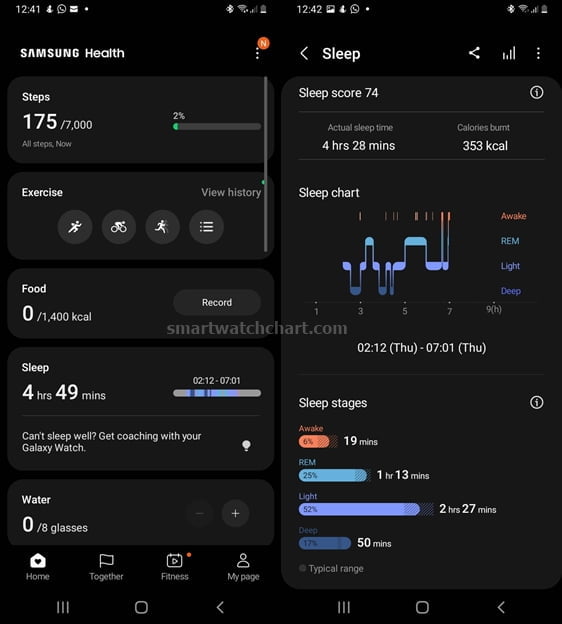
To see a more detailed result of your sleep, you will need to go to the Samsung Health app. In the app, you will see your sleep score, total sleep time, and actual sleep time. You will also see the time spent in each stage of sleep as well as your sleep consistency over a period of time.
How to Track Your Blood Oxygen During Sleep with Galaxy Watch 4
The red blood cells need to be able to carry an adequate amount of oxygen to other cells in the body for them to optimally carry out metabolic processes. So, it’s very important that you know your blood oxygen level during sleep. The normal blood oxygen level is 95% and above.
To track your blood oxygen during sleep with the Galaxy Watch 4, you will need to enable it, and this can be done in the Samsung Health app.
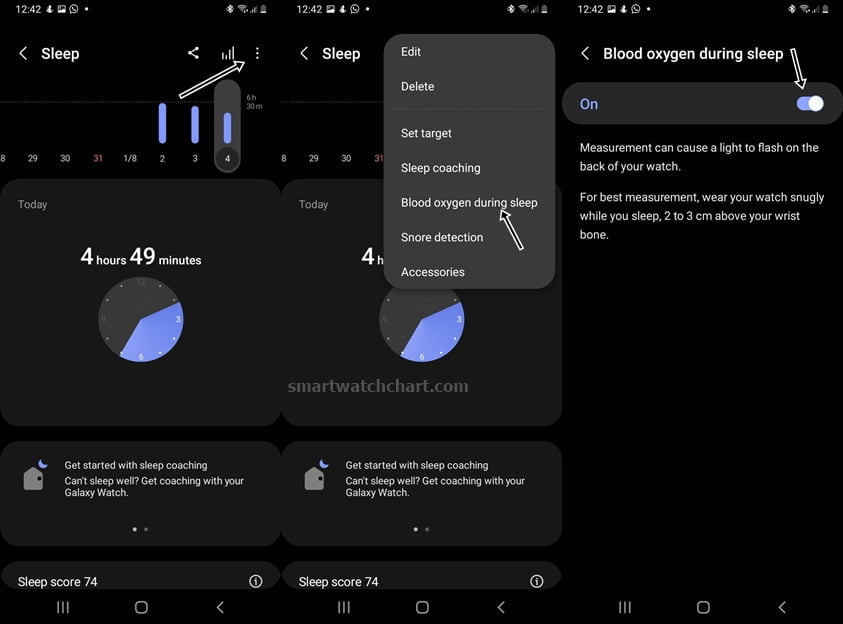
Open the Samsung Health app, find and select the sleep section, then tap on the three dots at the top right corner. Select blood oxygen during sleep and toggle it on.
Once you have enabled blood oxygen during sleep, the Galaxy Watch 4 will track your blood oxygen level when you wear it to sleep.
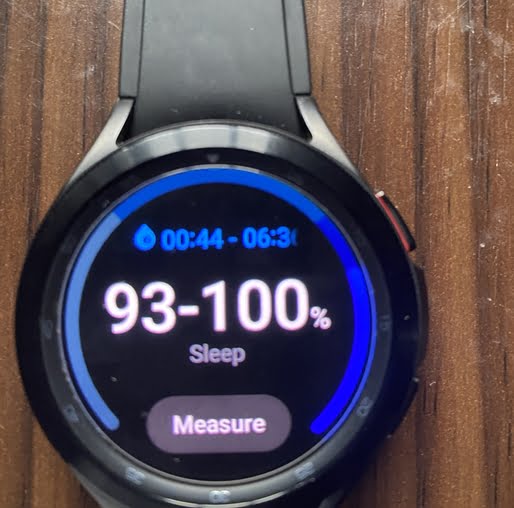
When you wake up in the morning, you can view your blood oxygen for last night right on the watch. Simply scroll to the spo2 tile on the watch to see your blood oxygen level.
How to Track Snoring with Galaxy Watch 4
Do you really want to know if your snore? The Galaxy Watch 4 can help you detect snoring. This has to be enabled as well in the Samsung Health app or from the Samsung Health app on the watch.
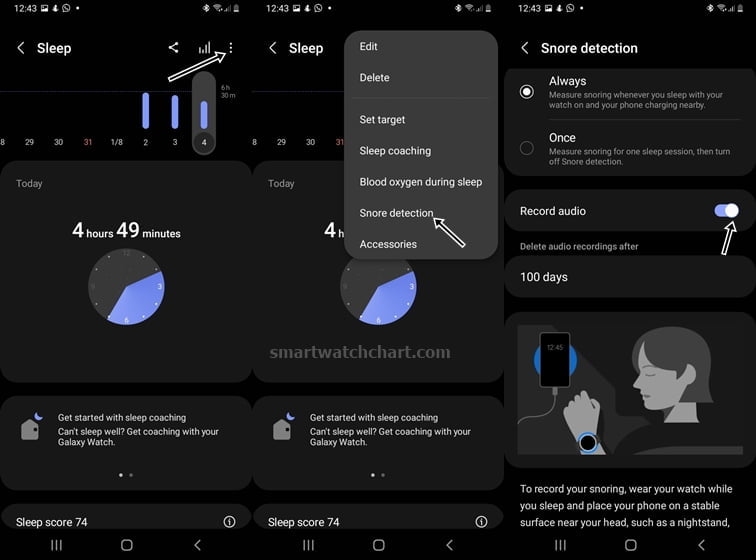
Open the Samsung Health app on your phone, find and select the sleep section. Then tap on the three dots at the top right corner, tap on snore detection from the list and toggle it on.
You have the option to enable snore detection always or once. You can also choose how long you want the watch to keep snoring data, it’s a maximum of 100 days.
After you have enabled and configured snore detection, you must keep your phone very close to your pillow for the Galaxy Watch 4 to detect and record snoring. The phone has to be charging or well charged to record snoring.
When you wake up in the morning, you can see and listen to your snoring data in the Samsung Health app. Just open the app, go to the Sleep section and scroll down to see snoring.
The Galaxy Watch 4 records your snoring in phases, and it shows the exact time snoring was detected as well as how many episodes of snoring were detected.
Galaxy Watch 4 Sleep Tracking Accuracy Test
To test the Sleep tracking accuracy of the Galaxy Watch 4, I wore it to sleep alongside the Apple Watch Series 7, Band 4 Pro, and Fitbit Versa 3.
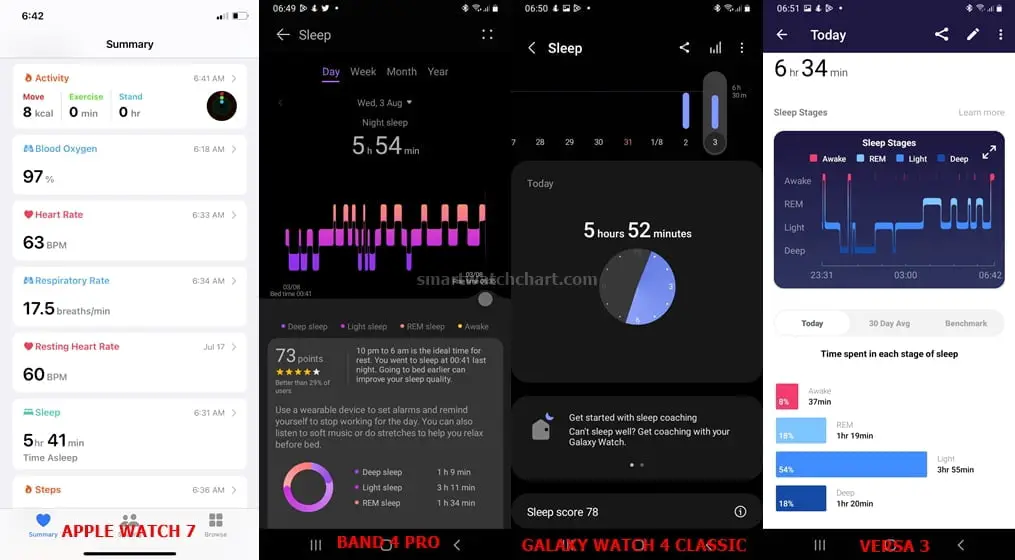
The results showed that the Galaxy Watch 4 is consistent and accurate in tracking my actual sleep time. However, going by the results, the amount of time spent in each stage varies across the different devices. Thus, I can’t authoritatively say how accurate the Galaxy Watch 4 is in tracking Sleep stages. Only a comparison alongside an EEG device can answer that correctly.

[su_list icon=”icon: heart” icon_color=”#2A0116″ indent=”0″ class=””]
- How to Use Google Map on Galaxy Watch 4 – Use Standalone on LTE Unit
- How to Get Google Assistant on Galaxy Watch 4
- How to Install Apps on the Galaxy Watch 4 – Beginners Guide
[/su_list]
What is Samsung Sleep Score?
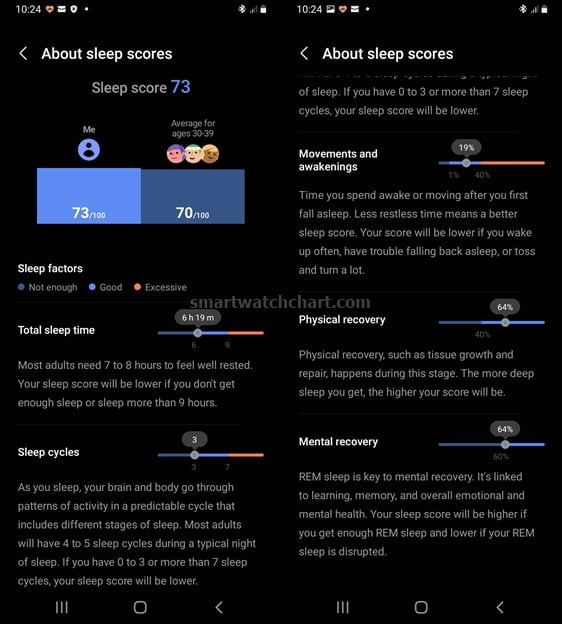
You will get a sleep score when you wear your Galaxy Watch 4 to sleep. This score is based on the following 5 factors.
- Total sleep time:
- Sleep cycles:
- Movement and awakenings:
- Physical recovery:
- Mental recovery:
You will get a higher score if sleep up 7-8hrs, and you will get a lower score if sleep less than 7hrs or more than 9hrs (note that this is based on my age).
You will get a low sleep score if your sleep cycle is lower than 3 or more than 7.
This refers to time spent awake after you first fall asleep. Your score will be lower if you wake often or toss and turn a lot.
Tissue growth and body repairs happen in deep sleep. You will get a higher score if you spend significant time in the N3 stage.
Memory rejuvenation occurs in the REM stage. You will get a high sleep score if you spend significant time in the REM stage.
The Samsung algorithm comprises and averages these scores to give you a sleep score. The orange color indicates excessive sleep, the steel blue color indicates poor sleep while the sky-blue color indicates good sleep. You will also see the average sleep score for individuals within your age range.
How Much Sleep Do You Need?
There is no one formula that tends to work for everyone as long as sleep is concerned. In fact, the pattern of sleep varies greatly among individuals of the same age bracket.
However. going by the averages, babies tend to get about 16-18hrs of night sleep which studies suggests is important for growth and memory development, it’s 9.5hrs of night sleep for children and teenagers. Meanwhile, a typical adult needs 7 to 8hrs of sleep to get fully rested. So, as an adult, you should aim to get as much as 7-8hrs of sleep daily. And to get a night of quality sleep, getting the appropriate amount of sleep in each stage is important. You should get 45-50% of light sleep, 25% of deep sleep, and 25% of REM sleep.
Conclusion
Wrapping things up, the Galaxy Watch 4 is no doubt a comprehensive activity tracker. It tracks your sleep in four stages, it can also track your blood oxygen during sleep and will detect and record snoring. And from my many tests and comparisons with other high-end smartwatches, it has proven to be a consistent and accurate sleep tracker.

